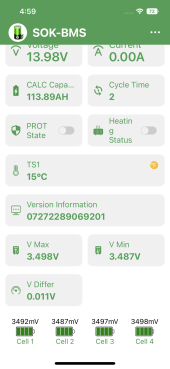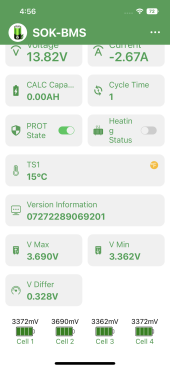I guess I'll see what I can work out with SOK.If the battery can't be charged to the 14.4-14.6V spec without triggering BMS cut-off, send it back. It doesn't meet spec.
You are using an out of date browser. It may not display this or other websites correctly.
You should upgrade or use an alternative browser.
You should upgrade or use an alternative browser.
14.2, 14.4, 14.6 - seems like there is no agreement on charging voltage
- Thread starter archjeb
- Start date
2 great pages that discuss this topic:
Page discussing drop in's like your SOK, Battleborns etc

This one's a LONG one but down the page goes into this topic in great detail with stats and evidence re the only need to go above 14 is for the internal cell balancing... a great page:
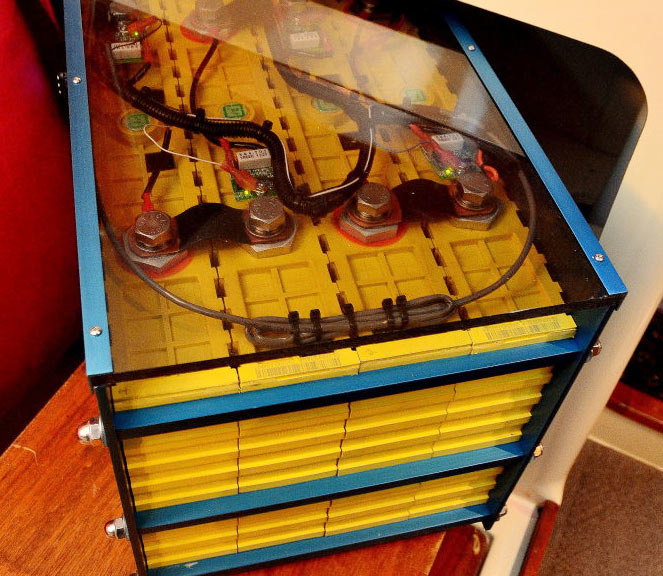
Page discussing drop in's like your SOK, Battleborns etc

Drop-In LiFePo4- Be an Educated Consumer
Lead is Dead (almost) Warning: This article is long and detailed. It may require two reads so the nuances and detail are not missed. You may be wondering why I am saying lead is dead ?The answer to that is simple; lead acid battery makers dug their own graves
marinehowto.com
This one's a LONG one but down the page goes into this topic in great detail with stats and evidence re the only need to go above 14 is for the internal cell balancing... a great page:

DIY LiFePO4 Batteries On Boats - Marine How To
DIY LiFePo4 On Boats Last edit;3/26/23:The base of this article was written a number of years ago (2010) but this does not mean the information here is outdated. We have been keeping it updated and have added to it when ever we had the time. This article deals
marinehowto.com
BradCagle
Solar Enthusiast
- Joined
- Aug 27, 2021
- Messages
- 578
If the battery can't be charged to the 14.4-14.6V spec without triggering BMS cut-off, send it back. It doesn't meet spec.
Most of these Chinese batteries spec it as 14.4 +-0.2
So 14.2v is probably the best they guarantee
sunshine_eggo
Happy Breffast!
Most of these Chinese batteries spec it as 14.4 +-0.2
So 14.2v is probably the best they guarantee
Then they need to change their datasheet:
SK12V100 Spec Sheet.pdf
 drive.google.com
drive.google.com
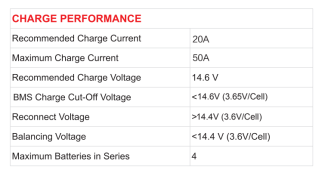
The whole charge to max voltage is a hangover from the lead-acid days. LFP cannot be undercharged and cause harm like lead acid. No need to run max to get virtually full capacity. Time to lay off the lead-acid mentality and enjoy the new world of LFP. Charge at 13.8-14.2 is fine.
hwse
Solar Enthusiast
- Joined
- Jan 2, 2021
- Messages
- 585
The simple truth is that you cannot charge to any voltage that is higher than what you have when the highest cell goes into OVP. I recently received a 460Ah sealed battery pack and out of the box, it had a 300mv imbalance and would hit 3.65v on cell #3 and cell #1 was only 3.35v. This happened when the pack voltage was 13.9v. Any attempt to charge above 13.9v would result in a OVP shutdown. Given the very large pack capacity of 460Ah and the tiny 100mA passive balancing, this imbalance will take a long to correct. I am now able to charge at 14.26v with the lowest cell now getting up to 3.465 so I can safely charge to 14.2v. Hopefully later this week I will get it completely top balances to that I can set by absorption voltage to 14.4v and get full capacity out of the pack.
BradCagle
Solar Enthusiast
- Joined
- Aug 27, 2021
- Messages
- 578
Then they need to change their datasheet:
SK12V100 Spec Sheet.pdf
drive.google.com
View attachment 130738
Yeah, that's pretty bold.
Pierre
Somewhere down South
- Joined
- Dec 21, 2019
- Messages
- 1,144
One always tries for the lowest but I would suggest that at the knees not more than 150mV but on the flat part of the curve about 20 - 50mV , lower being a bonus. I have an active 5A balancer connected permanently , charge or discharge. Works for me , others may differ.So what balance voltage/delta should I say its 'good enough at'? 50mV? 20mV? Or am I expecting too much here?
MrM1
I'm Here, But I'm Not All There
What do you like for Float, 3.38v?
MarcoWasRight
New Member
- Joined
- Aug 22, 2022
- Messages
- 71
Max charging voltage is 4.2V per cell.
I’m sure someone will get all bent out of shape about that one sentence. It is the true max safe charging voltage just like most lithium ion chemistries but common sense will tell you that past 3.35V you start to see the voltage climb rapidly and if your charging current is a fixed value then 2+2= there’s not much capacity up there. You decide for yourself how high you want to go. Most of the research and real world experience has shown us that past 3.50V you’re seeing maybe the last one or two percent of capacity. This also depends on how your charger cuts the current off. Most people follow the 0.05C rule.
Also, keep in mind I don’t really use BMS’s unless it’s a pack I know I’m not going to monitor so I’m free to charge up to 3.65 on a balance charger if I want to so long as my charge current is low enough for the balance current to stop any runners. I couldn’t fathom having an off the shelf battery with no access to the balance leads with how slow most of these BMS’s balance and worst of all the non Bluetooth BMS’s that have balance start set to 3.60V
Do whatever makes you happy. Maybe take notice that these BMS’s aren’t making you very happy.
I’m sure someone will get all bent out of shape about that one sentence. It is the true max safe charging voltage just like most lithium ion chemistries but common sense will tell you that past 3.35V you start to see the voltage climb rapidly and if your charging current is a fixed value then 2+2= there’s not much capacity up there. You decide for yourself how high you want to go. Most of the research and real world experience has shown us that past 3.50V you’re seeing maybe the last one or two percent of capacity. This also depends on how your charger cuts the current off. Most people follow the 0.05C rule.
Also, keep in mind I don’t really use BMS’s unless it’s a pack I know I’m not going to monitor so I’m free to charge up to 3.65 on a balance charger if I want to so long as my charge current is low enough for the balance current to stop any runners. I couldn’t fathom having an off the shelf battery with no access to the balance leads with how slow most of these BMS’s balance and worst of all the non Bluetooth BMS’s that have balance start set to 3.60V
Do whatever makes you happy. Maybe take notice that these BMS’s aren’t making you very happy.
IMHO a 2A or 4A charge won’t make much difference- whatever charge voltage you set, they will taper current as the battery voltage reaches that setting. Some chargers have a duration, some sense tail current - a level that is decidedly full charge and terminate.Rookie question here, but should I have stuck with the 2Amp charger? Or is 4Amps low enough to see if the BMS could actually balance that cell?
Or should I take the battery cover off and try to drain that single cell to try to force it some into balance?
On full discharge, its actually lower then the first 2 cells...so it makes me think that maybe there is something wrong with that cell. But since this is my first LiFePo4 rodeo, I have nothing to compare this to other than the 2 other SOK batteries that are all part of the same shipment.
Bleeding one cell at high knee is a quick way to bring it down to the level of the other cells. I have done this several times on my diy battery, and is very well balanced up to about 3.55Vpc.
You may need to repeat the process again at an interval. A severely degraded cell that doesn’t match the others is a warranty claim on a bought battery.
I use a 12V auto headlight bulb to bleed individual cells - done near full charge while charging to assist bms balancing. Only takes a minute or two to drop a cell down and let others catch up before the whole pack reaches the full voltage charge setting.
I don’t bounce off the bms over volt settings.
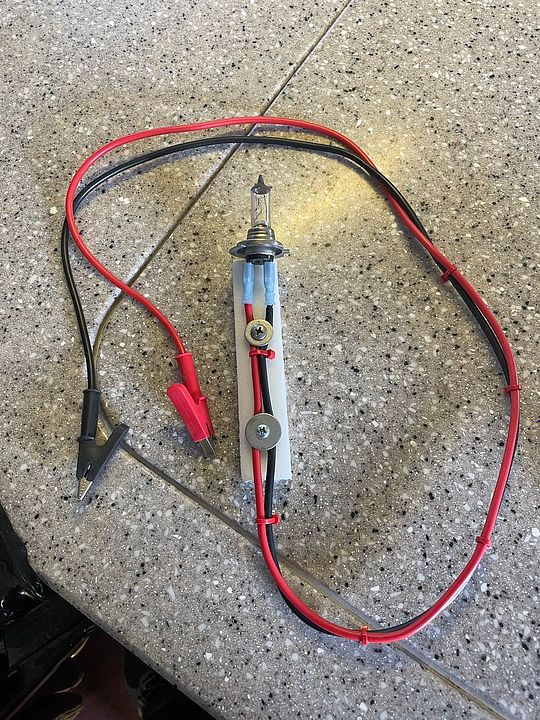
Last edited:
BradCagle
Solar Enthusiast
- Joined
- Aug 27, 2021
- Messages
- 578
Also, keep in mind I don’t really use BMS’s unless it’s a pack I know I’m not going to monitor so I’m free to charge up to 3.65 on a balance charger if I want to so long as my charge current is low enough for the balance current to stop any runners. I couldn’t fathom having an off the shelf battery with no access to the balance leads with how slow most of these BMS’s balance and worst of all the non Bluetooth BMS’s that have balance start set to 3.60V
Do whatever makes you happy. Maybe take notice that these BMS’s aren’t making you very happy.
I do the same with a few of my e-bike packs.
But I 100% agree on the balance lead issue. These battery manufactures should provide port where you can access the balance leads. They can call it diag port, and sell a little device which is basically just an active balancer.
John Frum
Tell me your problems
- Joined
- Nov 30, 2019
- Messages
- 15,230
Some BMSs don't balance unless the BMS is registering >= ~3 amps charge current.IMHO a 2A or 4A charge won’t make much difference- whatever charge voltage you set, they will taper current as the battery voltage reaches that setting.
John Frum
Tell me your problems
- Joined
- Nov 30, 2019
- Messages
- 15,230
I suspect you misunderstand me.My JBD balances at milliamperes. And not very darn much, half an amp or something. Balancing isn’t very impressive, or I’m just impatient. Lol
The current accounting in some BMSs needs to register a charge(which requires ~3 amps) in order to turn on balancing.
I have a JBD and the default configuration is to only balance during charge and from memory the current accounting works as described in the previous sentence.
KITROBASKIN
Solar Enthusiast
Please report back. Thinking I have a similar situation here but really not sure about the details brought up in this thread so skillfully by participating diysolar members.I guess I'll see what I can work out with SOK.
KITROBASKIN
Solar Enthusiast
I let the pair of 12V 100Ah SOK (in parallel) get plenty of time to float yesterday. Right after the Victron charge controller went back to bulk at the end of the day, I recorded these images. I have all the charge controller settings as CurrentConnected recommends (14.6V) and one Bluetooth display insists there is a load on the battery even though the inverter is totally off. I made a video showing that battery completely disconnected from anything yet the Bluetooth still showed a couple amps load.
Attachments
IMHO a 2A or 4A charge won’t make much difference- whatever charge voltage you set, they will taper current as the battery voltage reaches that setting. Some chargers have a duration, some sense tail current - a level that is decidedly full charge and terminate.
Bleeding one cell at high knee is a quick way to bring it down to the level of the other cells. I have done this several times on my diy battery, and is very well balanced up to about 3.55Vpc.
You may need to repeat the process again at an interval. A severely degraded cell that doesn’t match the others is a warranty claim on a bought battery.
I use a 12V auto headlight bulb to bleed individual cells - done near full charge while charging to assist bms balancing. Only takes a minute or two to drop a cell down and let others catch up before the whole pack reaches the full voltage charge setting.
I don’t bounce off the bms over volt settings.

For dropping a cell down by, lets say, 100mV, how long do you put your lamp on the cell? Just so I have a ball park idea? And you do this after you tripped the BMS on overcharge correct? Or is this during charge?
So SOK is telling me not to worry that it will balance itself out. Direct quote:Please report back. Thinking I have a similar situation here but really not sure about the details brought up in this thread so skillfully by participating diysolar members.
"""
I noticed this, this Voltage difference in range, you don't need to worry about this.
If you checked the capacity, it over 100Ah already.
Also, you could keep using, after using a while, this Voltage different will drop down.
"""
I'm getting full rated capacity on discharge (I did confirm that) with a resistive load of 45amps.
Once I draw down the battery a little, they do balance out. Its just on full charge where I run into this balance issue. Notice the screen shot below, they are all pretty close. This is after putting a 45Amp load for about 5minutes on the battery pack.
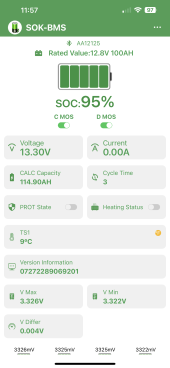
At this point, since I'm a LiFePo4 rookie, I have no conviction
Am I over thinking all this and should just install these batteries and go fishing
KITROBASKIN
Solar Enthusiast
Well said about going fishing. My numbers normalize after use of the batteries, but it is good to learn more about these things, right?
Thing is, Battleborn does not give the option of closely monitoring each cell in their battery packs. They may have more than one runaway cell in their sealed, not bluetoothed units.
Thing is, Battleborn does not give the option of closely monitoring each cell in their battery packs. They may have more than one runaway cell in their sealed, not bluetoothed units.
KITROBASKIN
Solar Enthusiast
This thread is very valuable because of the discussion of where to set the absorption voltage. How long should absorption be? Victron default was what, an hour? CurrentConnected says 15 minutes?
I believe both could be correct. Generally more voltage, less time. For light daily cycling... charging at the lower end and less time will still get over 95% and extend the life of the battery some. For occasional use, like fishing, perfectly OK to charge on the high side and get out on the water faster with 100% charge.This thread is very valuable because of the discussion of where to set the absorption voltage. How long should absorption be? Victron default was what, an hour? CurrentConnected says 15 minutes?
sunshine_eggo
Happy Breffast!
Max charging voltage is 4.2V per cell.
I’m sure someone will get all bent out of shape about that one sentence. It is the true max safe charging voltage just like most lithium ion chemistries but common sense will tell you that past 3.35V you start to see the voltage climb rapidly and if your charging current is a fixed value then 2+2= there’s not much capacity up there. You decide for yourself how high you want to go. Most of the research and real world experience has shown us that past 3.50V you’re seeing maybe the last one or two percent of capacity. This also depends on how your charger cuts the current off. Most people follow the 0.05C rule.
Also, keep in mind I don’t really use BMS’s unless it’s a pack I know I’m not going to monitor so I’m free to charge up to 3.65 on a balance charger if I want to so long as my charge current is low enough for the balance current to stop any runners. I couldn’t fathom having an off the shelf battery with no access to the balance leads with how slow most of these BMS’s balance and worst of all the non Bluetooth BMS’s that have balance start set to 3.60V
Do whatever makes you happy. Maybe take notice that these BMS’s aren’t making you very happy.
Please cite a LFP cell specification that permits this.
I know what you're saying, but it's old information, and it shouldn't be perpetuated.
Similar threads
- Replies
- 6
- Views
- 698
- Replies
- 20
- Views
- 2K
- Replies
- 9
- Views
- 707
- Replies
- 11
- Views
- 943



